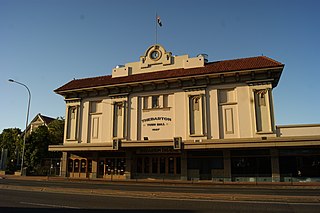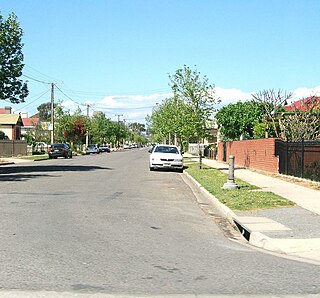
Victor Harbor is a town in the Australian state of South Australia located within the City of Victor Harbor on the south coast of the Fleurieu Peninsula, about 82 kilometres (51 mi) south of the state capital of Adelaide. The town is the largest population centre on the peninsula, with an economy based upon agriculture, fisheries, and tourism. It is a popular tourist destination, with the area's population greatly expanded during the summer holidays, usually by Adelaide locals looking to escape the summer heat.
Kensington Gardens is an eastern suburb of Adelaide, located within the City of Burnside. It includes a large recreational park, Kensington Wama, or Kensington Gardens Reserve.
Marryatville is a small suburb about 4–5 kilometres (2.5–3.1 mi) east of Adelaide's central business district, in the local council area of City of Norwood Payneham St Peters. Comprising low- to medium-density housing, two large schools, a church and several shops, it also has two creeks running through it. The first European settler on the land was George Brunskill in 1839, with part of the land purchased and laid out as a village in 1848 by James Philcox.

Semaphore is a northwestern suburb of Adelaide in the Australian state of South Australia. It is located on the Gulf St Vincent coastline of the Lefevre Peninsula about 14 kilometres (8.7 mi) from the Adelaide city centre.

The Thebarton Theatre, also known as the Thebbie Theatre or simply Thebbie/Thebby, is an entertainment venue located in the inner-western Adelaide suburb of Torrensville, South Australia. Built in 1926 as a combined town hall / picture theatre and officially known as Thebarton Town Hall and Municipal Offices, the building was opened in June 1928. It was listed on the South Australian Heritage Register on 23 September 1982.

Hilton is an inner western suburb of Adelaide, South Australia. It is located in the City of West Torrens, for which it is the council seat.
Wallis Cinemas, formerly Wallis Theatres, is a family-owned South Australian company that operates cinema complexes in greater Adelaide and regional South Australia.

The Capri Theatre is a heritage-listed cinema in Goodwood, a suburb of Adelaide, South Australia, built in the Art Deco style in 1941. It was formerly called the New Star Theatre, Goodwood Star, New Curzon, and Cinema Capri.

Merlin Cinemas Limited are a British cinema chain with Head Office based in England. The company was formed in 1990 and predominantly operates in small coastal towns. In many cases, the cinemas were saved from closure and run on very small margins, but they are supported by some of the larger ones in the group that have been extensively refurbished and modernised to include luxury screens with waiter service, plus licensed bars, restaurants and live theatre.

The Windsor Cinema is located at 98 Stirling Highway, Nedlands, Western Australia. It is an Art Deco cinema designed by the architect William T. Leighton and constructed in 1937. It is currently leased by Luna Palace Cinemas.

The Semaphore Library is a public library in Semaphore, South Australia. It was formerly the Semaphore Institute, Semaphore Town Hall, Ozone Theatre, and Semaphore Cinema, and is heritage-listed on both the state and national registers.

The Scone Civic Theatre is a heritage-listed cinema at 144 Kelly Street, Scone, Upper Hunter Shire, New South Wales, Australia. It was designed by Guy Crick and Bruce Furse and built from 1937 to 1938 by Mr A. F. Little. The property is privately owned. It was added to the New South Wales State Heritage Register on 21 February 2003.
Christopher Arthur Smith, also known as Chris Smith and Chris A. Smith, was a South Australian architect. He was a prolific designer of picture theatres and public buildings in Adelaide and regional South Australia during the 1920s and 1930s, and is recognised as one of the leading South Australian exponents of the Art Deco style.

Piccadilly Cinema(s), formerly Piccadilly Theatre and Forum Cinema, and also known as The Piccadilly, is a cinema located on the corner of O'Connell Street and Childers Street in North Adelaide, South Australia.

Dan Clifford was a well-known cinema entrepreneur and philanthropist in South Australia. He was also a keen promoter of the cinema industry, and owned 20 cinemas across the state at the time of his death, including several in Art Deco style, such as the Piccadilly Theatre and the Goodwood Star.
Ozone Theatres Ltd, formerly Ozone Picture Company and then Ozone Amusements Ltd, was a cinema chain based in Adelaide, South Australia, from 1911 until 1951, when it sold its theatres to Hoyts. It was founded by Hugh Waterman and friends, and was jointly run by him and seven sons, including Clyde Waterman and Sir Ewen McIntyre Waterman. S.A. Theatres and Ozone Theatres were subsidiary companies, and the chain was referred to as the Ozone circuit. It was one of two major film exhibitors in the state from after World War I until the late 1940s, the other being D. Clifford Theatres Limited. After 1938, Ozone dominated the market.
Wondergraph, Wondergraph Theatre and variations were names given first to a technology, and then to picture theatres run first by the Continental Wondergraph Company ; and then, in Adelaide, South Australia, by the Wondergraph Company (1910–1911), and then the Greater Wondergraph Company, established around 1911 and in existence until 1939.
The Odeon Star Semaphore Cinemas, usually referred to as the Odeon Star, is an independent multiplex cinema in the beachside Adelaide suburb of Semaphore, South Australia. It is the oldest purpose-built cinema in Adelaide, opened on 22 May 1920 as the Wondergraph Picture Palace.
Frank Kenneth Milne, usually referred to as F. Kenneth Milne, was an Australian architect based in Adelaide, South Australia. He was regarded as one of the leading architects in the state in 1920, and continued to design buildings even in retirement. He went into partnership with a series of other architects over the course of his career, including John Richard Schomburgk Evans, Charles Alexander Russell, and Rolfe Vernon Boehm. He is also known for his work as a cinema architect, having been the appointed architect for Ozone Theatres in the 1930s.
Victa Cinema is a state heritage-listed cinema in the town of Victor Harbor, South Australia. The original building was designed by noted cinema architect Chris A. Smith and opened in 1923, but was extensively damaged by fire and rebuilt in 1934 to designs by F. Kenneth Milne. This reconstructed building is thought to be one of the first buildings in South Australia created in a style known as streamlined architecture. Its ownership changed from its first private owner, to National Pictures, to Ozone Theatres in 1928, before being taken over by Hoyts in 1951. After partial closure in the 1960s it was run by a series of independent operators, with an extra screen being added in 1998 and later renovations in 2005. Since 2020 it has been owned by the City of Victor Harbor.











